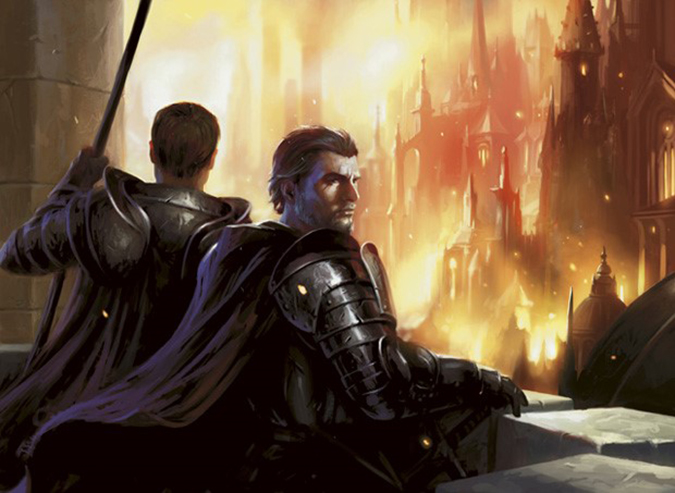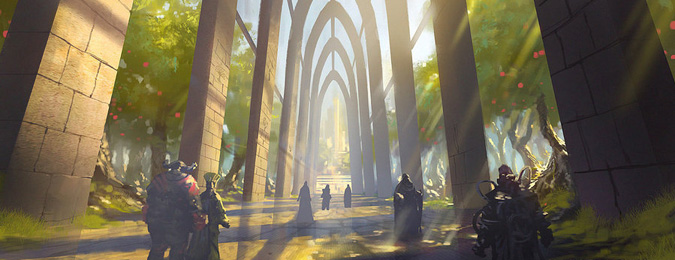This is an NPC deck that represents the Maze within the Ravnica story, which will be used in my new format
"Maze Runner". The rules for this format can be found below.
Introduction:

Welcome to the Implicit Maze of Ravnica! Guilds of Ravnica, select your champion now and prepare them for the maze run. They shall face many trials and be tested to their full magical capabilities. Many of them shall fall, but the one who makes it to the maze's end shall shape the future of the guildpact, and in turn, shape the future of Ravnica.
Players, you are the maze runners who shall compete for the future of Ravnica. Chose the guild you wish to align yourself with and prepare your libraries for a competition like no other.
Choose the legendary creature who shall be the creature form of yourself. From here on, a "player" will be known as a "Maze Runner".
RULES:

Building a deck: Before building a deck, decide what guild to represent. The guild can only be one of the two colour guilds from the Ravnica block. Then choose a legendary creature to represent your guild in the maze. That creature is your "Maze Runner". The creature you choose must be at least one of the colours in your chosen guild and cannot contain any colours that are not represented by your guild, this includes colourless creatures.
However, you may have non-creature artifacts in your deck.
Each player builds a 60 card deck, no more, no less. That deck cannot contain any lands or creatures, but may contain any other spell types, including artifacts and enchantments. The cards available to you are vintage legal cards with no restrictions. You may generate mana through artifacts and each player shares the NPC's lands, as if the Maze Runners are drawing power from the maze itself. The Maze Runner doesn't contribute to your 60 card limit, nor does the single Transguild Promenade, which each Maze Runner will have, and will start the game with it on the battlefield.
Although you cannot put creature spells into your library, you can have creatures on the battlefield under your control. For example, spells that create token creatures are instant and sorcery spells, not creature spells, therefore you are allowed to use them in your deck.
A player's deck represents the Maze runner's library of spells. Players have no life totals, however, and the legendary creature represents you, the player. The NPC deck may have creatures, but those creatures must be selected from the pauper pool of creatures. No uncommon, rare or mythic creatures should be used in the NPC deck.
The NPC deck follows the normal rules for lands, but the NPC deck can only contain guildgates. However, the NPC deck may tap those lands for mana of any colour. At the beginning of each player's upkeep, the guildgates untap and any player may use them as a mana source, but the gates only tap for their designated colours if a player taps them.
The NPC deck should be built like a cube, friends get together and decide on the way that the deck is constructed. The deck should contain a minimum of 100 cards and Maze's End, which is placed in the command zone at the start of the game. It may contain play sets of cards and also follows the vintage card legality, with no restrictions.
The Maze Runner:

As stated in the rules for building a deck, the "Maze Runner" should be at least one of the colours included in your chosen guild. Each Maze Runner starts the game with their Legendary creature that they have chosen to represent them, in play. If it would be put into a graveyard, library, into hand or into exile from anywhere, it goes to the command zone instead. For each time it would go to the command zone, it costs a further , which stacks for each time it has gone to that zone. However, the first time it enters the command zone in a game, it costs its normal CMC to cast, then a further thereafter.
At the beginning of your end step, if your Maze Runner is in your command zone, but didn't leave the battlefield this turn, you lose the game. At the start of your draw step, if you don't control your Maze Runner, you skip that draw and Scry 1 instead. Imagine that you are the Maze Runner, therefore, if you are not in play, you can't draw. To balance it though, the scry 1 helps to prevent being hindered further. Furthermore, spells cannot be cast until your Maze Runner is in play again.
Starting a game:

Before starting, each Maze Runner decides on a mutually agreeable way to determine who goes first.
The Maze Runner who starts should be left to the NPC deck, the NPC takes the first turn and then the first Maze Runner, then each other Maze Runner thereafter.
After the starting Maze Runner has been chosen and so on, each Maze Runner puts the legendary creature they have chosen for their library that represents them within the maze onto the battlefield. Then he or she puts a single Transguild Promenade onto the battlefield under their control, and draws seven cards as normal.
Then each Maze Runner does the same in turn order, from the left of the starting Maze Runner.
Mulligans follow the standard rules of Magic: The Gathering.
Once all Maze Runners have set-up, drawn their hands and finished taking mulligans, the NPC deck then draws its hand and puts a single Transguild Promenade onto the battlefield.
The Transguild Promenade represents the starting point of the maze and gives all Maze Runners a head start with their mana, as lands are not available to them in their libraries. To keep the maze one step ahead, as it should be, it also starts with one on the battlefield, as it is also apart of the maze anyway.
It enters the battlefield tapped as stated in its rule text, however, the mana doesn't have to be payed. It untaps on each Maze Runner's first untap step as they begin their first turn.
At the beginning of each Maze Runners' first turn, they may not attack the NPC. This is not due to summoning sickness however, so abilities may be activated.
Guildgates:

As previously mentioned in the section "Building a deck", only the NPC deck has lands and that deck must contain a play set of each guildgate.
When the NPC taps a guildgate for mana, it adds mana of any colour to its mana pool. When a Maze Runner taps the guildgates for mana, they add one mana of a colour produced by that guildgate.
Guildgates under the NPC's control may be used by any player, as well as the NPC. Guildgates under a Maze Runner's control can be used only by the one who controls them.
At the beginning of each Maze Runners' upkeep, the guildgates controlled by the NPC untap and then the Maze Runner who's turn it is, untaps all permanents he or she controls. The guildgates controlled by a Maze Runner untap on their untap phase as usual.
Whenever a guildgate is destroyed or exiled, it goes to the bottom of the NPC's deck. The same is effect occurs whenever a guildgate under the control of a Maze Runner is returned to hand. However, if the land is under the control of the NPC when it is sent to hand, it will return to the NPC's hand as normal.
Abilities and Spells:
As stated during the Introduction, players are their Maze Runners, therefore, they are the creature on the battlefield. Any spells that would normally be cast targeting a player, instead target the creature. An example would be: Lava Spike, this can now target the creature on the field that has been chosen to be a players Maze Runner. Another example being, Psychic Rebuttal which can be used to counter a spell that targets the Maze Runner creature. However, such spells can only target creatures that have been chosen as Maze Runners, but no other creatures on the field.
Also, spells that target creatures can also target the Maze Runner, as they are still creatures.
Maze Runners cannot target other Maze Runners or non-land permanents that they may have under their control with spells or abilities of permanents. They can only target the NPC or permanents under the NPC's control, as the Maze Runners' enemy is the maze itself. The same applies to combat, see combat rules further down.
However, permanents that trigger, due to something occurring or triggering on a Maze Runners upkeep, etc,
and permanents and spells that effect all players or permanents, are permanents that effect the environment and thus effect all Maze Runners and their permanents. Examples: Dictate of Karametra, Hive Mind, Genesis Chamber, Words of Wisdom, Rhystic Study and Overburden.
However, abilities that force Maze Runners to sacrifice or destroy permanents at the start of their upkeep, etc, don't target Maze Runners or force a Maze Runner to sacrifice or destroy themselves. This applies to the abilities of permanents controlled by Maze Runners and the NPC.
The only permanents that are controlled by Maze Runners that can be targeted by other Maze Runners, as well as the NPC are lands. The objective of the game is land control, which is achieved by fighting the NPC, a.k.a The Maze. But also by stealing lands from other Maze Runners, or completely wiping out the lands they control.
Any permanents that deal damage to its controller are dealt to the legendary creature, a.k.a The Maze Runner.
It is wise to take only permanents that deal little damage to your Maze Runner or take them with a Maze Runner with a high toughness value. Of course, you can buff you Maze Runner's power and toughness too.
Combat:
During the combat phase, a Maze Runner cannot attack another Maze Runner, this is to simulate being separated from one another in the maze. Each players' opponent is the maze itself, a.k.a the NPC deck. When a maze runner attacks the NPC, he/she attacks it directly and the NPC blocks if able. The decision of blocking is randomly generated through dice rolls. The numbers are assigned by the player to the left of the current player in turn order, the current player then makes the rolls required to determine how the NPC creatures block their Maze Runner.
When a Maze Runner deals combat to the maze, he/she then searches the NPC deck for a guildgate and puts it into play tapped under their control, then shuffles the deck. A Maze Runner must assign a total of *** combat damage before being allowed to search for a guildgate. The combat damage assigned by each Maze Runner is stacked until the total has been met, then that number is reset to 0.
When the NPC attacks a player, it is attacking the Maze Runner directly, not the player. You choose how your Maze Runner defends itself, the Maze Runner may fight any number of creatures. For each creature you choose not to fight, put the top card of your library into you deck. If you do have any other creatures on the battlefield under your control, you may block with them. Those creatures follow the normal rules for blocking, they can only block one creature at a time, unless stated otherwise by an ability or effect.








